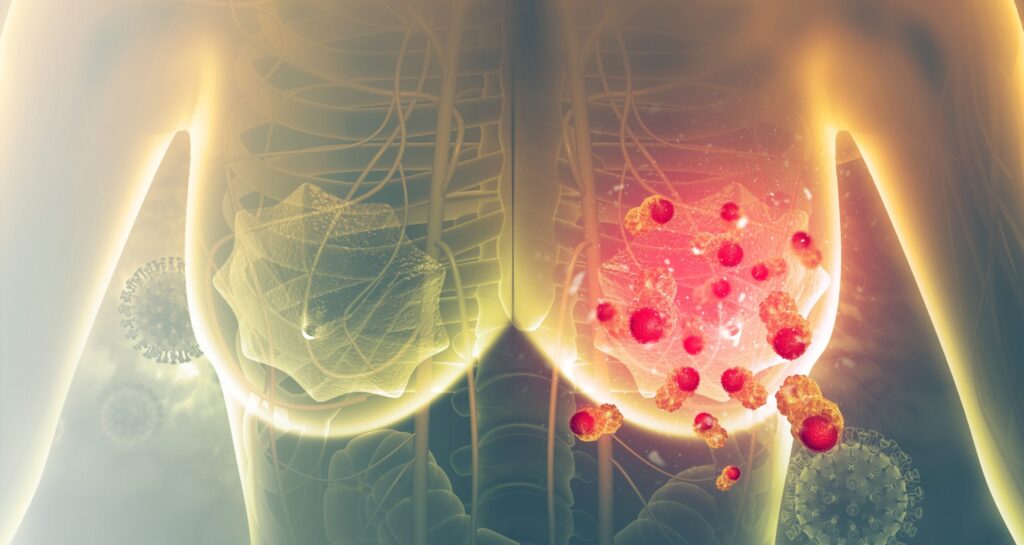Understanding of Triple-Negative Breast Cancer
Why is TNBC so hard to treat?
Triple-negative breast cancer (TNBC) is defined by cells that lack estrogen receptors (ER), progesterone receptors (PR), and HER2. That means doctors cannot use hormonal therapies or HER2-targeted drugs that work in other breast cancers. TNBC tends to be more aggressive and fast-growing, and it often affects younger women. It also relapses earlier and can spread to organs like the lungs and brain more readily than other types. In short, TNBC has fewer targeted treatment options and a higher risk of early recurrence, so outcomes have traditionally been worse than for other breast cancers.
Common myths about TNBC
One myth is that “TNBC means no treatment options.” Not true. Although TNBC lacks some hormone targets, chemotherapy, surgery, and radiation are very effective for many patients. New targeted approaches are also emerging. For example, PARP inhibitors (drugs that block DNA repair) work in BRCA-mutated TNBC, and antibody–drug conjugates (ADCs) like sacituzumab govitecan target TNBC cells directly. Clinical trials of these and other therapies show real progress.
Another myth is that “TNBC always comes back” or “can’t be cured.” While TNBC can be more aggressive, many women with early-stage TNBC are cured by standard treatments. In fact, recent studies show very high cure rates: for example, adding immunotherapy to chemo in early TNBC raised 5-year survival rates to about 86%. This means the majority of patients are still alive five years out – quite hopeful news.
Don’t let fear rule. It’s true TNBC is challenging, but every year brings new advances. We now have proven treatments (like chemo and immunotherapy) and a pipeline of experimental therapies that give real hope.

Current Treatments by Stage
Early Stage (I–IIIA TNBC)
In early-stage TNBC, treatment usually starts with surgery to remove the tumor (either lumpectomy or mastectomy) and often radiation therapy after surgery. Most patients also get chemotherapy, which may be given before surgery (neoadjuvant) or after surgery (adjuvant) to kill any remaining cancer cells and lower recurrence risk. For example, a common approach is neoadjuvant chemotherapy (like paclitaxel, carboplatin, and anthracyclines) followed by surgery. About 30–40% of patients achieve a “pathologic complete response” (no tumor seen at surgery), which is linked to excellent outcomes.
Recently, immunotherapy has been added for high-risk early TNBC. The KEYNOTE-522 trial showed that giving pembrolizumab (Keytruda) with chemo before and after surgery increased the 5-year survival from ~82% to ~87%. This approach is now FDA-approved for patients with stage II–III TNBC at high risk of recurrence. In practice, if the tumor is large or has aggressive features, doctors may recommend pembrolizumab + chemotherapy before and after surgery to improve cure rates.
If a patient has an inherited BRCA1/2 mutation, we also use PARP inhibitors. These drugs (e.g. olaparib/Lynparza or talazoparib/Talzenna) block DNA repair in cancer cells. In trials of high-risk early TNBC with BRCA mutations, adding an adjuvant PARP inhibitor after chemo significantly reduced recurrence. Today, adding a PARP inhibitor after chemo is a standard option for patients with germline BRCA mutations and stage II/III TNBC.
Locally Advanced TNBC (Stage III)
Locally advanced TNBC (large tumors or many involved lymph nodes) is usually treated similarly to early TNBC but often starts with neoadjuvant therapies. In practice, patients receive strong chemotherapy regimens — sometimes combined with immunotherapy (as above) — to shrink the tumor before surgery. The goal is to achieve a complete response. Getting no tumor at surgery (pathologic complete response) is linked to a much lower risk of recurrence. If cancer is still present after neoadjuvant treatment, extra therapies (like capecitabine or clinical trials of new drugs) may be used after surgery.
In summary for early and locally advanced disease: surgery and chemo are the mainstays. New tools like pembrolizumab and PARP inhibitors are added to these standard treatments for patients who need extra help. This gives patients the best chance for a cure.
Metastatic TNBC (Stage IV)
Once TNBC has spread to other organs, treatment focuses on control and quality of life. Chemotherapy is still a key option and can shrink tumors and relieve symptoms. Common chemo drugs include taxanes (paclitaxel), anthracyclines, and platinum agents (like carboplatin).
Immunotherapy is also now part of first-line care for metastatic TNBC that is PD-L1 positive (about 20–40% of cases, depending on test). The KEYNOTE-355 trial showed that adding pembrolizumab to chemo in PD-L1–positive mTNBC extended progression-free survival. This combo is FDA-approved for first-line treatment of unresectable or metastatic TNBC that tests PD-L1+. (Atezolizumab was also approved earlier, but it is no longer used after a failed confirmatory trial.)
For metastatic TNBC with a BRCA mutation, PARP inhibitors are approved as well (e.g. olaparib or talazoparib), since they showed good responses by exploiting the tumor’s DNA repair weakness. In practice, a patient with mTNBC and BRCA might receive a PARP inhibitor after one or two lines of chemo.
An important new option is sacituzumab govitecan (Trodelvy), an FDA-approved ADC for TNBC. This drug carries chemotherapy directly into TNBC cells via the TROP2 protein. Trodelvy is given after at least two prior treatments for metastatic TNBC and has been shown to improve survival. In fact, Trodelvy alone now stands as a preferred choice by guidelines for previously treated mTNBC. Ongoing research is even testing Trodelvy earlier in treatment.
In short, metastatic TNBC therapy today often includes several lines: chemo, plus immunotherapy if PD-L1+, plus targeted drugs for BRCA+ patients, plus Trodelvy in later lines. This multimodal approach is much better than “no options.” And new therapies (see below) promise to expand the metastatic arsenal even more.

Expected New Treatments
Exciting advances are on the horizon for TNBC. Several cutting-edge strategies are under study:
- Antibody–Drug Conjugates (ADCs): These are “guided missiles” carrying chemo to cancer cells. Trodelvy (sacituzumab govitecan) targets TROP2 and is already in use for metastatic TNBC. New ADCs are coming. Datopotamab deruxtecan (Dato-DXd) is a TROP2-directed ADC with a potent topoisomerase I payload; it showed promise in early trials and is being studied in phase III trials both in advanced and early TNBC. Another novel ADC, sacituzumab tirumotecan (SKB264), also targets TROP2 but delivers a camptothecin chemotherapy; in a phase III trial for late-stage TNBC it dramatically doubled progression-free survival versus standard chemo. These and other ADCs (targeting different proteins) may become new standards.
- Novel Immunotherapies: Beyond PD-1/PD-L1 drugs, bispecific antibodies and cell therapies are being tested. For example, KN046 is a bispecific antibody that blocks both PD-L1 and CTLA-4 checkpoints; in a Phase II trial with nab‑paclitaxel in first-line metastatic TNBC, KN046 achieved responses in ~44% of patients. Researchers are also exploring CAR-T and TIL cell therapies (living immune cells) against TNBC, though those are early. Cancer vaccines (therapeutic vaccines) are under investigation too. The main idea is to further train the immune system to fight TNBC.
- PARP and DNA Repair Drugs: PARP inhibitors are already used in BRCA-mutant TNBC, but new DNA repair drugs are in development. Next-generation PARP1 inhibitors (e.g. AZD5305) aim to be more potent and better tolerated. Combinations of PARP inhibitors with immunotherapy or other agents are also in trials. For example, trials are testing pembrolizumab (immunotherapy) together with talazoparib (a PARP inhibitor) versus chemo in metastatic TNBC. These strategies could help patients who have BRCA mutations or other DNA-repair defects.
- Targeting Other Pathways: Scientists are trying to hit other cancer pathways. AKT inhibitors like capivasertiband ipatasertib (oral drugs targeting the PI3K/AKT pathway) were tested in TNBC. The phase III CAPItello-290 trial added capivasertib to chemo as first-line treatment; it showed a modest delay in progression but did not significantly extend overall survival. Still, research continues on PI3K/AKT drugs, sometimes in molecularly selected patients (e.g. tumors with PIK3CA/AKT1/PTEN mutations). Other targets being explored include androgen receptors (in the “luminal AR” TNBC subset) and cancer-promoting enzymes (like VEGF, EGFR), although those efforts have been challenging.
- Combining Treatments: Many trials combine new drugs with existing therapies. For example, combining two different types of immunotherapy (PD-1 blockers with CTLA-4 blockers or vaccines) or pairing an ADC with immunotherapy is common in trials. The idea is to attack TNBC on multiple fronts at once.
Below is a sampling of recent or ongoing clinical trials illustrating these advances:
| Trial Name | Drugs | Mechanism | Setting | Status |
|---|
| ASCENT-05 / AFT-65 | Sacituzumab govitecan + Pembrolizumab | TROP2 ADC + PD-1 inhibitor | Early-stage TNBC (residual tumor) | Ongoing (Primary completion expected 2025) |
| ASCENT-04 | Sacituzumab govitecan + Pembrolizumab | TROP2 ADC + PD-1 inhibitor | Metastatic TNBC (1st line, PD-L1+) | Ongoing (Primary completion expected 2026) |
| TROPION-Breast04 | Datopotamab deruxtecan + Durvalumab | TROP2 ADC + PD-L1 inhibitor | Early-stage TNBC (neoadjuvant) | Ongoing (Recruiting, primary completion 2027) |
| TROPION-Breast05 | Datopotamab deruxtecan ± Durvalumab | TROP2 ADC ± PD-L1 inhibitor | Metastatic TNBC (PD-L1 CPS≥10) | Ongoing (Recruiting, primary completion 2026) |
| OptiTROP-Breast01 | Sacituzumab tirumotecan (SKB264) | TROP2 ADC (camptothecin payload) | Metastatic TNBC (after ≥2 treatments) | Ongoing (Interim results 2024; final 2025) |
| KN046 (Phase II) | KN046 + Nab-paclitaxel | Bispecific anti–PD-L1/CTLA-4 + chemo | 1st-line metastatic TNBC | Ongoing (Primary completion expected 2025) |
| CAPItello-290 | Capivasertib + Paclitaxel | AKT inhibitor + chemo | 1st-line metastatic TNBC | Ongoing (Primary completion expected 2025) |
Each of these trials (and many others) is a step toward personalizing TNBC care. Unlike the old days when TNBC meant one-size-fits-all chemo, researchers are now matching treatments to tumor features (like PD-L1 status, BRCA mutation, etc.) or creating entirely new therapies.
Overall, there is real reason for optimism: today’s patients have more options than ever, and tomorrow’s patients may benefit from immunotherapy, ADCs, targeted drugs, or even vaccines tailored to their cancer.
Key Points for Patients and Caregivers:
- TNBC is aggressive but not hopeless – many patients are cured with current treatments.
- Standard therapy depends on stage, with surgery and chemo for early TNBC, and immunotherapy added for high-risk cases.
- Metastatic TNBC is managed with chemo, plus immunotherapy or targeted drugs when applicable.
- Exciting news: Numerous trials are testing new drugs (see list above). ADCs (like sacituzumab and datopotamab), PARP inhibitors, and novel immunotherapies are either approved or on the way, expanding options.
- Hope and proactive care are vital. Stay in close contact with your oncology team to learn about any suitable clinical trials or new therapies. The TNBC landscape is rapidly evolving, and ongoing research is focused on giving patients better outcomes and more hope than ever before.
Source: Authoritative cancer center and research publications were used (American Cancer Society, Breast Cancer Research Foundation, peer-reviewed journals, and FDA reports) to ensure accurate, up-to-date information e.g., bcrf.org, ascopost.com, curetoday.com, onclive.com, nature.com, onclive.com. Each clinical trial mentioned has details from official trial summaries or press releases to provide context on the drugs, their mechanisms, and who they target.



What if you’re tnbc, stage 4, pd-L1 negative and no genetic involvement? I can’t see anything for that in the works…
Thanks for your question. In addition to conventional chemotherapy, antibody-drug conjugates (ADCs) like sacituzumab govitecan (Trodelvy) have shown effectiveness in treating TNBC, regardless of PD-L1 status or genetic mutations. It’s important to note that Trodelvy is currently approved for metastatic TNBC (mTNBC) after at least two prior systemic therapies, including one for metastatic disease. Another promising ADC, datopotamab deruxtecan (Dato-DXd), is currently in Phase 3 trials and has also demonstrated encouraging results. Hope that helps; if you have any further questions, please feel free to reach out to our team via Patient Savvy Facebook Messenger.